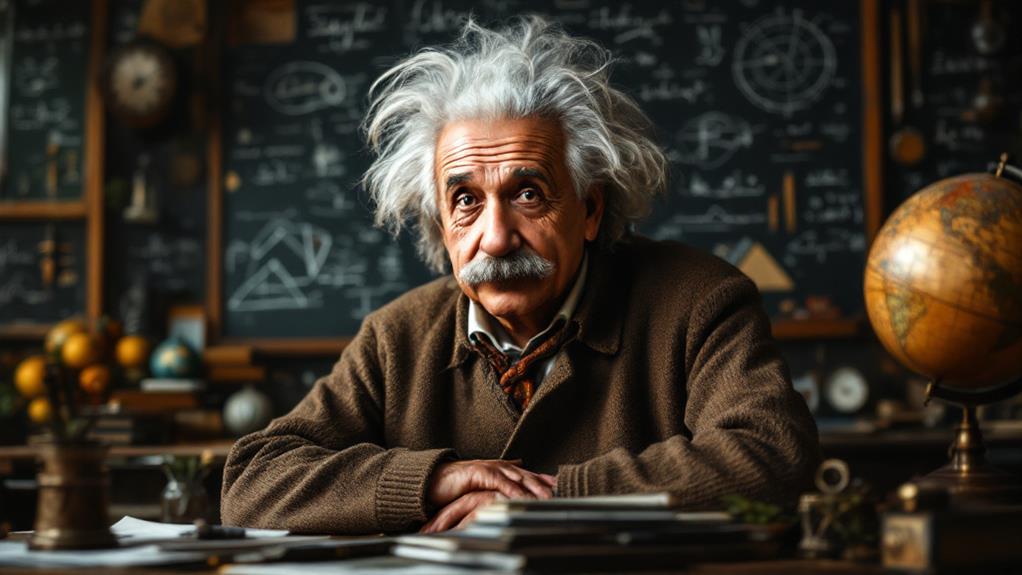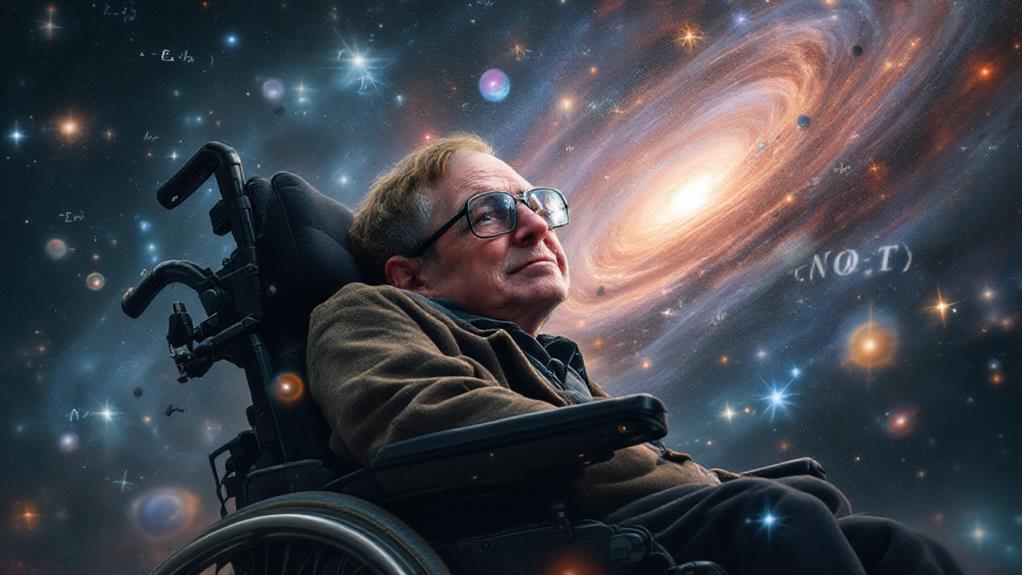Interesting Facts About Marie Curie: The Life of a Nobel Prize-Winning Scientist
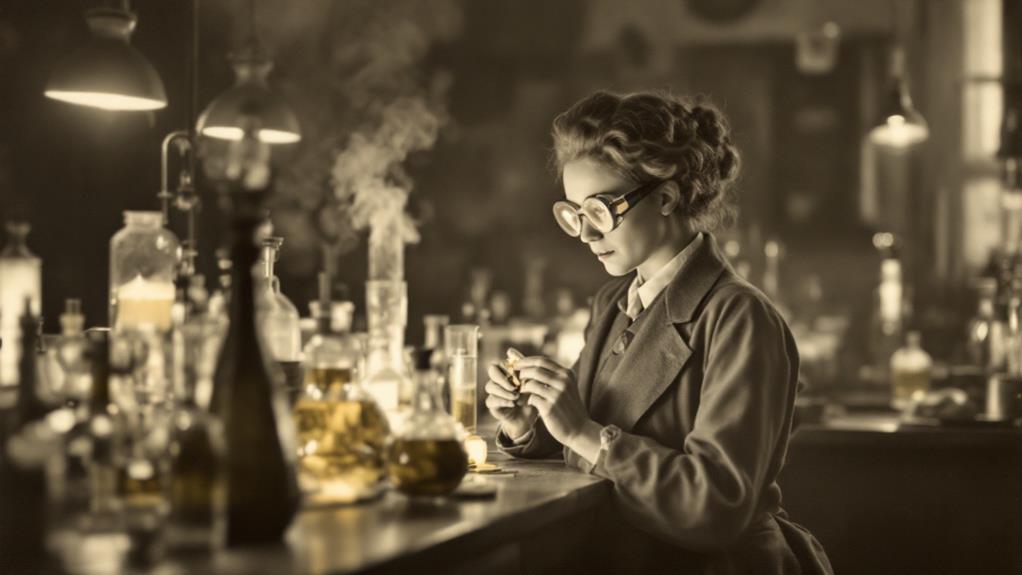
Marie Curie was a brilliant scientist who overcame immense challenges to revolutionize our understanding of radioactivity. Born in Poland, she moved to France to pursue her education, eventually becoming the first woman to win a Nobel Prize and the only person to win in two scientific fields. Curie unearthed two new elements, polonium and radium, and coined the term "radioactivity." During World War I, she developed mobile X-ray units for battlefield medicine. Despite facing discrimination and personal tragedy, Curie's dedication to science never wavered. Her legacy continues to inspire generations of scientists and shape modern medicine. Explore more fascinating details about this exceptional woman's life and achievements.
Early Life and Education
From the outset of her life, Marie Curie showed exceptional promise. Born Maria Sklodowska in Warsaw, Poland, in 1867, she grew up in a family that valued education. Her parents were teachers, instilling in her a love for learning from an early age. Despite facing financial hardships and the loss of her mother to tuberculosis when she was just ten, Marie excelled in her studies.
Her childhood experiences shaped her determination and work ethic. As a young girl, you'd find her at the top of her class, demonstrating a particular aptitude for mathematics and physics. However, Marie faced obstacles due to her gender and the political climate in Russian-controlled Poland. Unable to attend university in her homeland, she worked as a governess to save money for her education abroad.
At 24, Marie finally realized her dream of studying at the Sorbonne in Paris. There, she threw herself into her studies, often forgetting to eat as she immersed herself in scientific pursuits. This dedication would lay the foundation for her pioneering work in radioactivity and her future Nobel Prizes.
Groundbreaking Radioactivity Research
Marie Curie's laboratory became the birthplace of radioactivity research. She and her husband Pierre dedicated countless hours to studying uranium rays, leading to the uncovering of two new radioactive elements: polonium and radium. You'll be amazed to learn that they processed tons of pitchblende ore to isolate just a tiny amount of radium.
Curie's work revolutionized our understanding of atomic structure and radioactivity. She coined the term "radioactivity" and developed methods to measure it. Her research laid the foundation for modern nuclear physics and chemistry.
You might not know that Curie also pioneered the development of radium-based treatments for cancer. During World War I, she invented mobile X-ray units, nicknamed "petites Curies," to diagnose injured soldiers on the battlefield.
Despite the dangers of working with radioactive materials, Curie continued her research tirelessly. She didn't patent her discoveries, believing they should benefit humanity freely. Her transformative work earned her two Nobel Prizes, making her the first person to win Nobel Prizes in two different scientific fields. Curie's dedication to science and her exceptional discoveries continue to inspire researchers today.
Nobel Prizes and Scientific Achievements
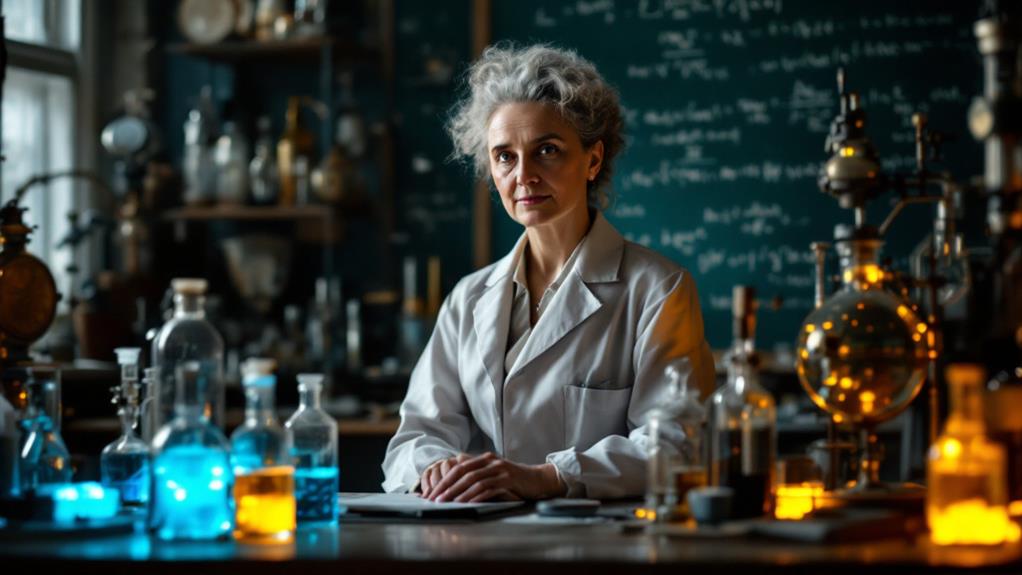
The Nobel Prize, science's most prestigious honor, recognized Marie Curie's pioneering work not once, but twice. In 1903, she shared the Physics Prize with her husband Pierre and Henri Becquerel for their radioactive revelations. Eight years later, in 1911, she won the Chemistry Prize solo for her chemistry innovations, including the revelation of polonium and radium.
Curie's scientific achievements extended far beyond these accolades. Her work laid the foundation for modern radiation therapy and nuclear medicine. You'll be amazed by the breadth of her contributions:
- Developed methods for isolating radioactive isotopes
- Discovered two new elements: polonium and radium
- Coined the term "radioactivity"
- Created mobile X-ray units for World War I field hospitals
- Established the Radium Institute in Paris
Her dedication to science was unfaltering, even in the face of gender discrimination and health risks. Curie's transformative research on radioactivity opened up new fields of study and revolutionized our understanding of atomic structure. Her legacy continues to inspire scientists worldwide, particularly women in STEM fields. Curie's achievements remind us that persistence and passion can lead to extraordinary scientific breakthroughs.
Personal Life and Challenges
Despite her pioneering scientific achievements, Marie Curie faced numerous personal challenges throughout her life. You might be surprised to learn that she struggled with depression and financial difficulties, even after winning her Nobel Prizes. Curie's personal struggles were compounded by the loss of her husband, Pierre, in a tragic accident in 1906, leaving her a widow with two young daughters to raise.
Balancing family responsibilities with her scientific pursuits wasn't easy for Curie. She had to juggle motherhood and her career, often working late into the night in her laboratory. Despite these challenges, she remained dedicated to her research and her children's education. Curie also faced discrimination as a woman in a male-dominated field, and her reputation was tarnished by a scandal involving a romantic relationship with a married colleague. Throughout it all, she maintained her focus on science and education, even as her health deteriorated due to prolonged exposure to radiation. Curie's perseverance in the face of personal and professional obstacles makes her scientific achievements all the more exceptional.
World War I Contributions

During World War I, Curie's scientific knowledge took on a new dimension of importance. You might be surprised to learn that she played a vital role in wartime radiography efforts. Curie developed mobile X-ray units, nicknamed "petites Curies," which revolutionized battlefield medicine. These units allowed doctors to quickly locate shrapnel and bullets in wounded soldiers, saving countless lives.
Curie's contributions extended beyond radiography. She also engaged in chemical research during conflict, focusing on the production of radioactive materials for medical use. Her proficiency in radioactivity proved useful to the war effort.
Trained over 150 women as radiological assistants, Curie personally drove X-ray vehicles to the front lines. She advocated for the use of radon gas to sterilize infected tissue, helped establish the Radium Institute in Paris for wartime research, and donated her Nobel Prize gold medals to support the war effort.
Despite facing discrimination as a woman in science, Curie's dedication to her work and her country during this critical period solidified her reputation as both a brilliant scientist and a humanitarian.
Legacy in Science and Medicine
Having revolutionized our understanding of radioactivity, Marie Curie's legacy in science and medicine continues to shape research and medical practices today. Her momentous work laid the foundation for modern radiation therapy, which is now an essential tool in cancer treatment. You'll find her influence in hospitals worldwide, where X-ray machines and radiotherapy equipment save countless lives.
As one of the pioneering women in STEM, Curie's achievements paved the way for future generations of female scientists. Her success challenged gender norms in the scientific community and inspired women to pursue careers in physics, chemistry, and other scientific fields.
Curie's scientific legacy in physics extends far beyond her Nobel Prizes. Her discoveries of polonium and radium opened up new avenues of research in nuclear physics and radioactivity. Today, scientists continue to build upon her work, exploring applications in energy production, medical imaging, and environmental monitoring. The Marie Curie Actions program, established by the European Union, honors her memory by funding research and innovation projects across Europe, ensuring that her impact on science endures well into the future.
Marie Curie's Laboratory Notebooks
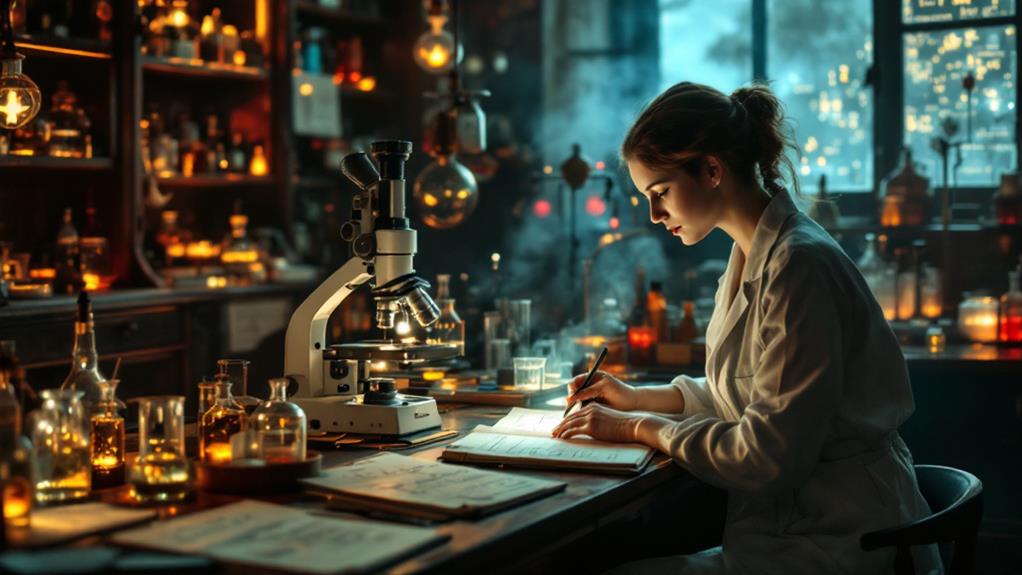
Marie Curie's laboratory notebooks offer a unique glimpse into the mind of this brilliant scientist. These private notebooks contain detailed records of her experiments, observations, and thoughts throughout her groundbreaking career. You'll find meticulous laboratory protocols, raw data, and Curie's personal reflections on her work.
Interestingly, Curie's notebooks are still radioactive today, over a century after she wrote them. They're stored in lead-lined boxes and require special handling. If you want to study them, you'll need to sign a waiver and wear protective gear.
Marie Curie's laboratory notebooks cover her entire scientific career, from 1897 to 1934. The notebooks are written in a mix of French and Polish. Some pages contain pressed flowers and personal notes. They provide viewpoints into Curie's rigorous scientific methods, and reveal her struggles and triumphs in research.
Curie's laboratory notebooks aren't just historical artifacts; they're precious resources for understanding the scientific process and the development of radioactivity research. They continue to inspire scientists and historians alike, offering a tangible connection to one of the most influential scientists in history.
Posthumous Honors and Recognition
Numerous posthumous honors have been bestowed upon Marie Curie, cementing her legacy as one of the most influential scientists in history. You'll find her name gracing various institutions, awards, and public spaces worldwide. The Marie Curie Actions program, established by the European Commission, supports researchers in their careers, while the Marie Skłodowska-Curie Medal recognizes outstanding achievements in chemistry.
Public memorials dedicated to Curie can be found in many countries. In Warsaw, you'll see a striking statue of her in front of the Radium Institute she founded. Paris hosts the Musée Curie, preserving her laboratory and showcasing her scientific contributions. Commemorative awards in her name are presented annually, including the Marie Curie Award by the Society of Radiological Technologists.
Curie's image has appeared on currency, stamps, and even in pop culture. She's been featured in films, books, and TV shows, introducing new generations to her pioneering work. UNESCO declared 2011 the International Year of Chemistry, partly in celebration of the centennial of Curie's Nobel Prize in Chemistry. Her enduring influence continues to inspire scientists and researchers worldwide.
